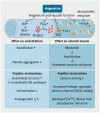Magnesium in Prevention and Therapy
- PMID: 26404370
- PMCID: PMC4586582
- DOI: 10.3390/nu7095388
Magnesium in Prevention and Therapy
Abstract
Magnesium is the fourth most abundant mineral in the body. It has been recognized as a cofactor for more than 300 enzymatic reactions, where it is crucial for adenosine triphosphate (ATP) metabolism. Magnesium is required for DNA and RNA synthesis, reproduction, and protein synthesis. Moreover, magnesium is essential for the regulation of muscular contraction, blood pressure, insulin metabolism, cardiac excitability, vasomotor tone, nerve transmission and neuromuscular conduction. Imbalances in magnesium status-primarily hypomagnesemia as it is seen more common than hypermagnesemia-might result in unwanted neuromuscular, cardiac or nervous disorders. Based on magnesium's many functions within the human body, it plays an important role in prevention and treatment of many diseases. Low levels of magnesium have been associated with a number of chronic diseases, such as Alzheimer's disease, insulin resistance and type-2 diabetes mellitus, hypertension, cardiovascular disease (e.g., stroke), migraine headaches, and attention deficit hyperactivity disorder (ADHD).
Keywords: ADHD; Alzheimer’s disease; asthma; cardiovascular disease; diabetes mellitus; hypomagnesemia; magnesium.
Figures
References
-
- Cotton F.A., Wilkinson G. Anorganische Chemie. Chemie GmbH; Weilheim, Germany: 1967.
-
- Weast R.C. Handbook of Chemistry and Physics. CRC Press; Boca Raton, FL, USA: 1987.
-
- Hollemann A.F., Wiberg E. Lehrbuch der Anorganischen Chemie. De Gruyter; Berlin, Germany: 1964.
Publication types
MeSH terms
Substances
LinkOut - more resources
Full Text Sources
Other Literature Sources
Medical




